Ancient Egyptian coinage began with a barter system using goods like grain and oil, later evolving to metal weights such as silver rings and gold pieces. Minted coins were officially introduced during the Ptolemaic period (323–30 BC), influenced by Greek models and featuring rulers like Ptolemy I and Cleopatra VII. Coins carried symbolic imagery and served as tools of power and trade. With Cleopatra’s fall, Roman tetradrachms replaced Egyptian silver, and Egypt's economy became a closed Roman system. Mints in Memphis and Alexandria produced coins blending Greek and Egyptian elements, offering valuable insights into Egypt’s cultural and economic evolution.
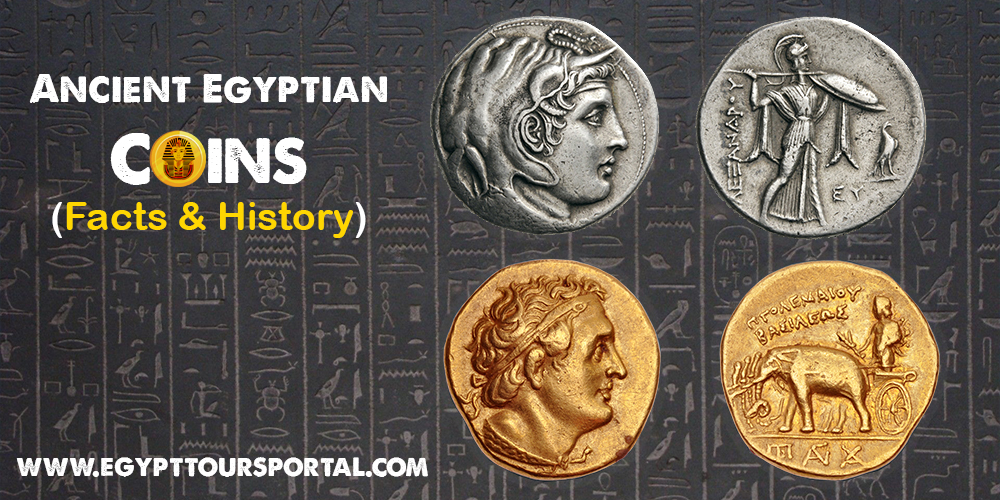
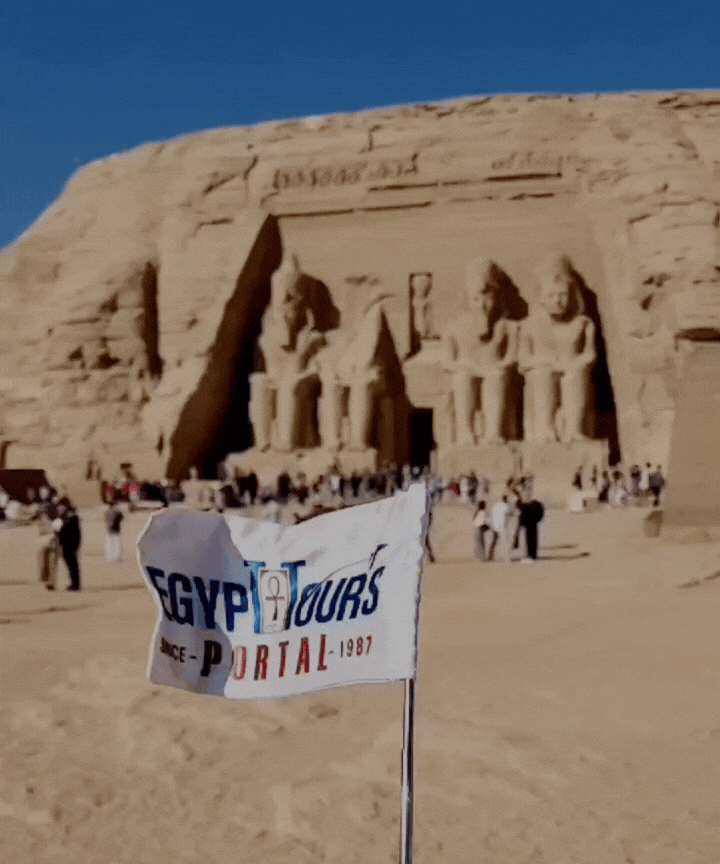
The Ancient Egyptian coins were always in a constant state of transformation throughout its history, the system of barter was the official currency, grain, beer, and oil served as a kind of coinage through most of its history even after the introduction of coined money in the second half of the first millennium BC during the Ptolemaic kingdom (323 BC-30 BC), the ancient Egyptians understood the importance of metal as it was used as a means of exchange, in Egypt old kingdom (2570-2150 BC) but no evidence proves they used coined metal.
In the final days of Egypt new kingdom (1570-1070 BC), non-coin form of silver shaped like rings and gold pieces shaped like sheep were exchanged centuries before the minting of coins from different metals. Silver was much scarcer than gold in Ancient Egypt. The ancient Egyptian society had many currencies and coins, but after the foundation of the Ptolemaic kingdom, an enforced policy of a single currency was established.
At the time of Cleopatra VII, silver suffered a very large degree of debasement. Due to the demise of the Ptolemaic empire, the silver coinage totally disappeared and was replaced by the Roman tetradrachms, the official currency of the Roman Empire. Egypt became a moderate region as a closed system similar to the Ptolemaic system, that point that the Roman currencies denarii and aurei didn't circulate in provincial Egypt at all.
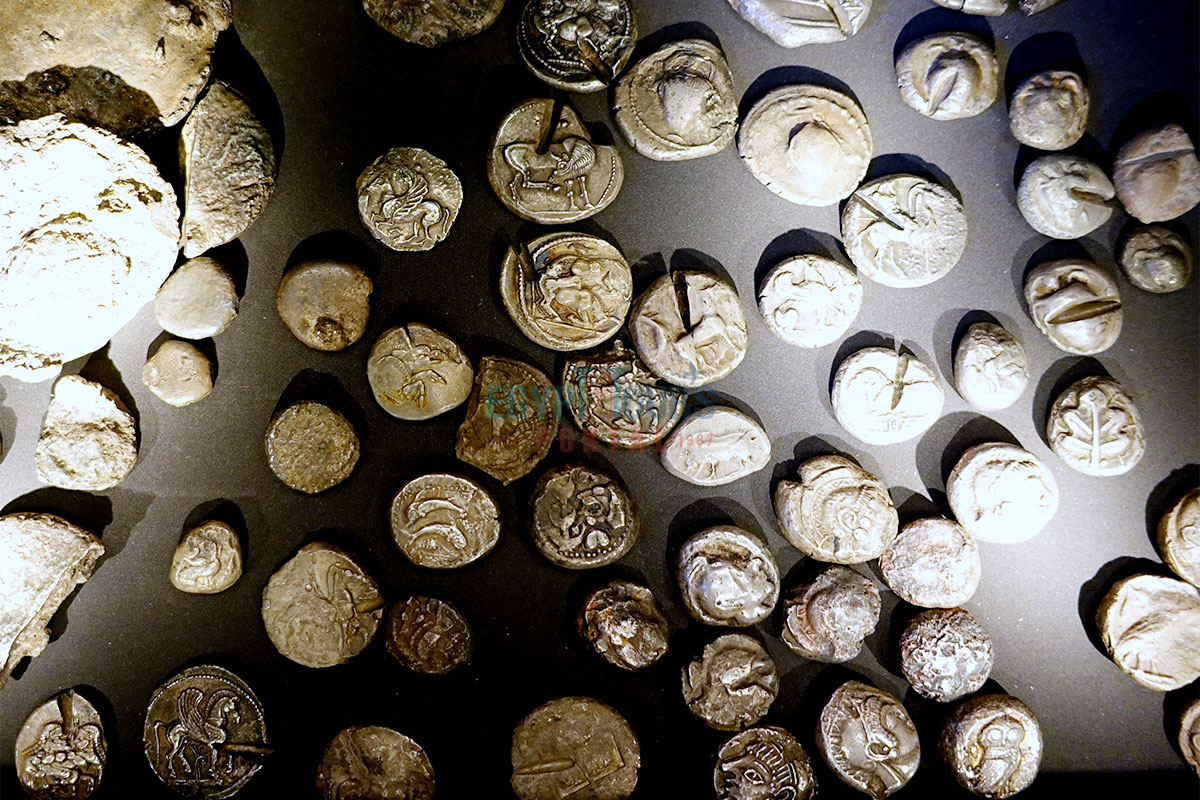
Ancient Egyptian coins, while not as prominent as those from Greece or Rome, began appearing around the late Pharaonic period, particularly after Alexander the Great’s conquest in 332 BCE. The types of coins minted in ancient Egypt can be primarily categorized based on the ruling empire or dynasty of the time, including Ptolemaic, Roman, and Byzantine influences.
During the Ptolemaic dynasty, coins often depicted the reigning monarchs, such as Cleopatra or Ptolemy I, and included silver tetradrachms and gold octadrachms. Later, Roman occupation introduced a range of bronze and silver coins, featuring emperors like Augustus and Tiberius.
Byzantine coins followed, showing Christian iconography alongside Greek text. Unlike modern coins, these ancient examples were symbols of wealth, power, and religious beliefs, frequently adorned with profiles of ancient Egyptian rulers, ancient Egyptian deities, and ancient Egyptian symbols to emphasize authority and divine support.

In ancient Egypt, coins were named primarily for their Greek or Roman influences. Among the most notable names were the tetradrachm, a large silver coin with a value equaling four drachms, and the octadrachm, a rarer gold coin worth eight drachms. During the Ptolemaic era, these coins were often called by Greek names like obol, drachm, and stater, indicating values within the Greek monetary system that were tailored to Egyptian use.
Under Roman rule, Egyptian coins continued to bear Greek nomenclature, with occasional Latin inscriptions, to ease the ancient Egyptian trade across the empire. These ancient coin names reflect the merging of Egyptian culture with the powerful Hellenistic and Roman traditions that influenced its economy and trade.
Explore the magnificent trade of the ancient Egyptian civilization
Read More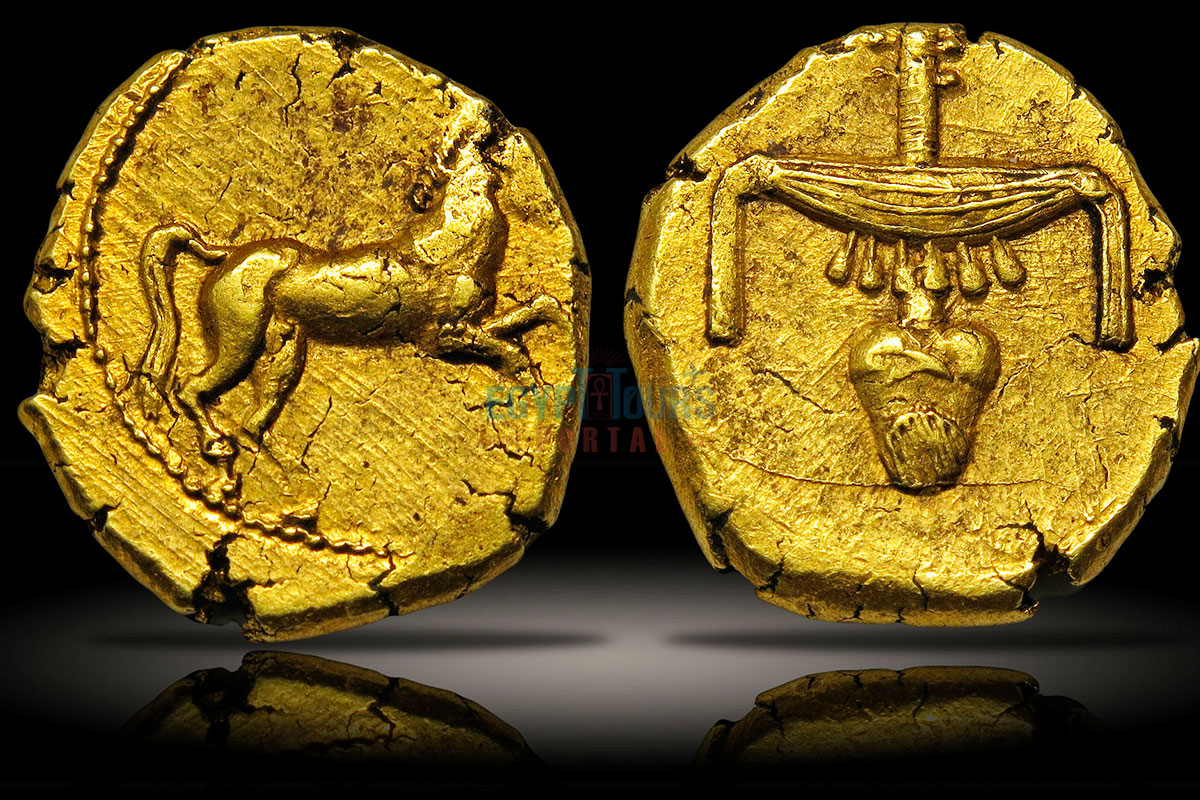
Determining the precise value of ancient Egyptian coins is complex, as they varied according to metal, weight, and economic factors of the time. In general, silver coins, such as the tetradrachm, held significant value and purchasing power, often equivalent to several days’ wages for a laborer. Gold coins, like the octadrachm, were considerably more valuable and likely reserved for wealthier classes or large transactions, possibly in governmental or military exchanges.
During Roman rule, coins held an exchange value determined by imperial decree, linking them to the broader Roman economy. However, coin value fluctuated based on the metal’s purity and regional economic conditions, reflecting ancient Egypt’s integration into a larger Mediterranean trade network.

Before Ancient Egypt started officially using coins as its official currency in 500 BC, the Egyptians used a system of value based on the weights of various metals like silver and copper. These metals were used to determine the value of other materials. The Ptolemaic kingdom coinage was struck in different standards, as it used the Phoenician weight (14.2 g) in creating it.
The design of the Ptolemaic coinage followed contemporary Greek currencies. The coin had an eagle standing on a thunderbolt, which was an ordinary symbol of the Ptolemaic dynasty. The kings and queens played a role as a medal, like a coin, was created portraying Ptolemy I and his wife Berenice I.
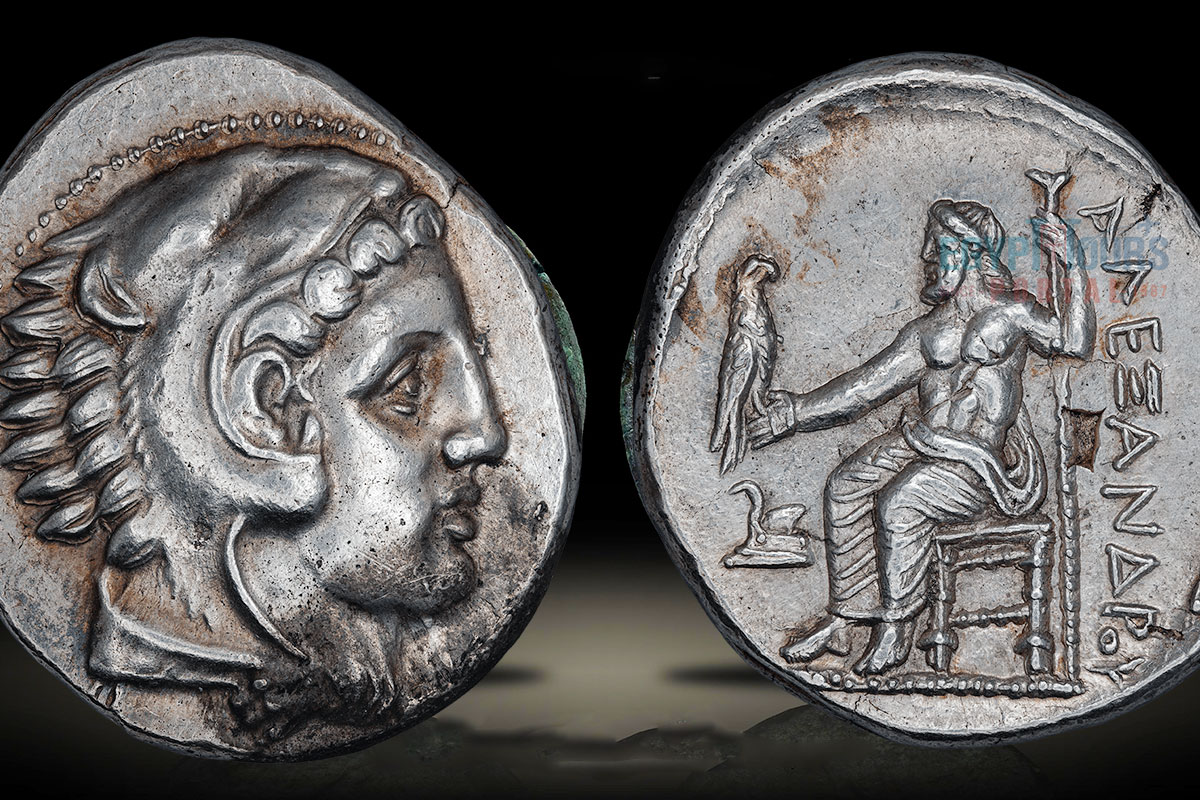
The history of coin minting in ancient Egypt, particularly during the Ptolemaic period under Greek influence, highlights Egypt's economic and political developments. Ptolemaic coin-making mirrored Seleucid practices, using sophisticated methods and imported silver, essential for trade, governance, and economic stability. The first Ptolemaic mint was in Memphis, but operations later moved to Alexandria, the new capital, due to its strategic location along sea trade routes.
Alexandria became the center of Egyptian coin minting, producing silver tetradrachms with distinct designs that combined Greek and Egyptian symbols, promoting the Ptolemaic rulers' image and legitimacy. These designs symbolized Alexandria’s cultural fusion, illustrating the blend of Egyptian tradition and Greek influence. Minting techniques resembled Seleucid methods, using manual striking and high-quality silver, enhancing the coins' acceptability in trade networks.
Imported silver facilitated the ancient Egyptian economy, supporting trade and military aims. This coinage system set a precedent for later Egyptian dynasties, continuing into the Roman period and providing historians with insights into Egypt’s economic and political landscape. Ptolemaic coinage thus reflects Egypt's cultural, economic, and political significance in the ancient world, cementing Alexandria’s legacy as a center of influence.
Discover the incredible significance of gold in ancient Egyptian civilization
Read MoreThe history of Ancient Egypt is very vast and full of countless details & wonders. Don't miss the chance to explore the incredible beauty of the ancient Egyptian civilization by booking a golden Egypt tour and boarding a Nile river cruise on its magic lifestream and discover all the hidden secrets in the magical destinations of Cairo, Alexandria, Luxor, and Aswan.
Private 4 Days Cairo Tour Packages for British Travelers 4 days Cairo Egypt Tour pac...
Tour Location: Cairo – Giza...
5 Days Cairo and Alexandria Tour Package For British Travelers 5 days Cairo and Alex...
Tour Location: Cairo/Giza/Alexandria...
6 Days Cairo, Luxor & Aswan Tour Package For British Travelers 6 days Cairo, Lux...
Tour Location: Cairo/Giza/Aswan/Luxor...
Amazing 7 Days Cairo and Hurghada Holiday for British Travelers 7 Days Cairo & H...
Tour Location: Cairo – Giza – Hurgh...
Ancient Egyptian coins were primarily made from silver, bronze, and gold. Silver coins, such as the tetradrachm, were common and highly valued for trade, while gold coins were rarer and held for significant transactions. Bronze was often used for smaller, everyday transactions, particularly under Roman rule, when lower-value coins were in circulation to support the broader economy. These metals not only conveyed economic worth but also symbolized power, as their origin and minting were often controlled by the ruling authority.
The earliest coins minted in Egypt likely date back to the 4th century BCE, during the reign of Ptolemy I, a successor of Alexander the Great. These coins marked Egypt's official entry into the Hellenistic monetary system and were typically adorned with symbols of royal authority, such as images of Alexander or Ptolemy himself. However, while coins emerged during this period, Egypt had long operated on a barter system and commodity-based exchanges.
Yes, but the concept of “money” as coinage arrived later. In Pharaonic times, wealth and trade were primarily managed through a barter system using goods like grain, livestock, and precious metals. Coins were introduced with Greek and Roman influences, making it easier to conduct standardized trade with the Mediterranean world. The adoption of coins enabled Egyptians to participate more efficiently in the broader economic system of the Hellenistic and later Roman empires.
Before coins, ancient Egyptians relied on a barter system with staple commodities such as barley and bread used as informal currency. When Greek and Roman influence began to shape Egyptian society, standardized currency was introduced in the form of silver tetradrachms, gold staters, and later, Roman denarii. Coins circulated widely during the Ptolemaic and Roman periods, bringing Egypt into the more structured Mediterranean economic network.
Quantifying ancient Egypt's total wealth is challenging, but the civilization was immensely rich in resources, land, and skilled labor. Grain from the fertile Nile Valley, precious metals like gold from Nubia, and extensive trade networks enriched the kingdom substantially. Egypt’s prosperity made it a desirable territory for foreign powers like the Greeks and Romans, who utilized Egyptian wealth to sustain their own empires. While modern valuations are speculative, Egypt’s wealth in terms of agriculture, minerals, and craftsmanship positioned it as one of the most valuable ancient economies.
Ancient Egyptian coins varied in appearance, often featuring symbols and portraits specific to the ruling power of the time. Coins from the Ptolemaic era frequently showed profiles of monarchs, like Ptolemy I, surrounded by Greek inscriptions, and sometimes depicted deities like Zeus or Egyptian gods. Roman coins bore imperial profiles alongside Roman symbols, often with Greek inscriptions for Egyptian use. Over time, Byzantine coins introduced Christian iconography, blending Egyptian cultural elements with new religious influences.
The entire country of Egypt deserve to be explored with its every heavenly detail but there are places that must be seen before any other such as the breathtaking Hurghada's red sea, The wonders of Cairo the pyramids of Giza, the great sphinx, the Egyptian Museum, Khan El Khalili Bazaar, the wonders of Luxor like Valley of the Kings, Karnak & Hatshepsut temple and the wonders of Aswan such as Abu Simbel temples, Philea temple, Unfinished obelisk and The Wonders of Alexandria like Qaitbat Citadel, Pompey's Pillar and Alexandria Library. Read more about the best places to visit in Egypt.
If you want to apply for a Visa On Arrival that lasts for 30 days then you should be one of the eligible countries, have a valid passport with at least 6 months remaining and pay 25$ USD in cash, as for the E-Visa for 30 day you should have a valid passport for at least 8 months, complete the online application, pay the e-visa fee then print the e-visa to later be presented to the airport border guard. You could also be one of the lucky ones who can obtain a free visa for 90 days. Read more about Egypt travel visa.
Egypt has a variety of delicious cuisines but we recommend “Ful & Ta’meya (Fava Beans and Falafel)”, Mulukhiya, “Koshary”, a traditional Egyptian pasta dish, and Kebab & Kofta, the Egyptian traditional meat dish.
The best time to travel to Egypt is during the winter from September to April as the climate becomes a little tropical accompanied by a magical atmosphere of warm weather with a winter breeze. You will be notified in the week of your trip if the Climate is unsafe and if any changes have been made.
You should pack everything you could ever need in a small bag so you could move easily between your destinations.
We have been creating the finest vacations for more than 20 years around the most majestic destinations in Egypt. Our staff consists of the best operators, guides and drivers who dedicate all of their time & effort to make you have the perfect vacation. All of our tours are customized by Travel, Financial & Time consultants to fit your every possible need during your vacation. It doesn't go without saying that your safety and comfort are our main priority and all of our resources will be directed to provide the finest atmosphere until you return home.
You will feel safe in Egypt as the current atmosphere of the country is quite peaceful after the government took powerful measures like restructuring the entire tourist police to include all the important and tourist attractions in Egypt. Read more about is it safe to travel to Egypt.
Wear whatever feels right and comfortable. It is advised to wear something light and comfortable footwear like a closed-toe shoe to sustain the terrain of Egypt. Put on sun block during your time in Egypt in the summer to protect yourself from the sun.
The best activity is by far boarding a Nile Cruise between Luxor and Aswan or Vise Versa. Witness the beauty of Egypt from a hot balloon or a plane and try all the delicious Egyptian cuisines and drinks plus shopping in old Cairo. Explore the allure and wonders of the red sea in the magical city resorts of Egypt like Hurghada and many more by diving and snorkeling in the marine life or Hurghada. Behold the mesmerizing western desert by a safari trip under the heavenly Egyptian skies.
There are a lot of public holidays in Egypt too many to count either religious or nation, the most important festivals are the holy month of Ramadan which ends with Eid Al Fitr, Christmas and new years eve. Read more about festivals & publich holidays in Egypt.
Egypt is considered to be one of the most liberal Islamic countries but it has become a little bit conservative in the last couple of decades so it is advised to avoid showing your chest, shoulders or legs below the knees.
Arabic is the official language and Most Egyptians, who live in the cities, speak or understand English or at least some English words or phrases. Fewer Egyptians can speak French, Italian, Spanish, and German. Professional tour guides, who work in the tourism sector, are equipped to handle visitors who cannot speak Arabic and they will speak enough English and other languages to fulfill the needs of all our clients.
The fastest way is a car, of course, a taxi. If you are in Cairo ride a white taxi to move faster or you could board the fastest way of transportation in Egypt metro if the roads are in rush hour.
The temperature in Egypt ranges from 37c to 14 c. Summer in Egypt is somehow hot but sometimes it becomes cold at night and winter is cool and mild. The average of low temperatures vary from 9.5 °C in the wintertime to 23 °C in the summertime and the average high temperatures vary from 17 °C in the wintertime to 32 °C in the summertime. The temperature is moderate all along the coasts.
It is the home of everything a traveler might be looking for from amazing historical sites dating to more than 4000 years to enchanting city resorts & beaches. You will live the vacation you deserve as Egypt has everything you could possibly imagine.









